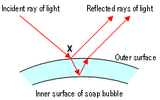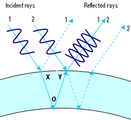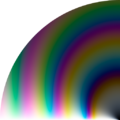- Colours of a soap film
-
The iridescent colours of soap bubbles are caused by interfering of (internally and externally) reflected light waves and are determined by the thickness of the film. This phenomenon is not the same as the origin of rainbow colours (caused by the refraction of internally reflected light), but rather are the same as the phenomenon causing the colours in an oil slick on a wet road.
As light impinges on the film
- some of it reflects off of the outer surface
- some of it enters the film and reemerges after reflecting off the second surface
- some of it enters the film and reemerges after bouncing back and forth between the two surfaces from 1 to n times
The total reflection observed is determined by the interference of all these reflections. Since each traversal of the film causes a phase shift proportional to the thickness of the film and inversely proportional to the wavelength, the result of the interference depends on these two quantities. So at a given thickness, interference is constructive for some wavelengths and destructive for others, so that white light impinging on the film is reflected with a hue that changes with thickness.
A change in colour can be observed while the bubble is thinning due to evaporation and draining. Thicker walls cancel out red (longer) wavelengths, causing a blue-green reflection. Later, thinner walls will cancel out yellow (leaving blue light), then green (leaving magenta), then blue (leaving a golden yellow). Finally, when the bubble's wall becomes much thinner than the wavelength of visible light, all the waves in the visible region cancel each other out and no reflection is visible at all. When this state is observed, the wall is thinner than about 25 nanometers, and is probably about to pop. This phenomenon is very useful when making or manipulating bubbles as it gives an indication of the bubble's fragility.
Interference effects also depend upon the angle at which the light strikes the film, an effect called iridescence. So, even if the wall of the bubble were of uniform thickness, one would still see variations of colour due to curvature and/or movement. However, the thickness of the wall is continuously changing as gravity pulls the liquid downwards, so bands of colours that move downwards are usually observed.
-
In the diagram above a ray of light hits the surface at point X. Some of the light is reflected, but some travels through the bubble wall and is reflected at the other side. When light directed from low index material strikes a high index material (air to film), there is a 180 degree phase shift just from the reflection (a "hard" reflection). So the film thicknesses discussed for red and blue light in the panels to the right are incorrect by half a wavelength.
-
In this diagram we look at two rays of red light (rays 1 and 2). Both rays are split as before and follow two possible paths, but we are interested only in the paths that are represented by the solid lines. Consider the ray emerging at Y. It consists of two rays on top of one another: the bit that went through the bubble wall for ray 1 and the bit that was reflected off the outer wall of ray 2. Ray one has traveled XOY further than ray 2. Since XOY happens to correspond to an integer multiple of the wavelength of red light, the two rays are in phase (the humps and troughs are together).
-
This is similar to the previous diagram except the wavelength is different. This time XOY is not an integer multiple of the wavelength of blue light and so ray 1 and 2 arrive at y out of step. The troughs of ray 1 line up with the humps of ray 2 and the two rays cancel each other out. The overall effect is that no blue light will be reflected for this thickness of bubble.
Wikimedia Foundation. 2010.





